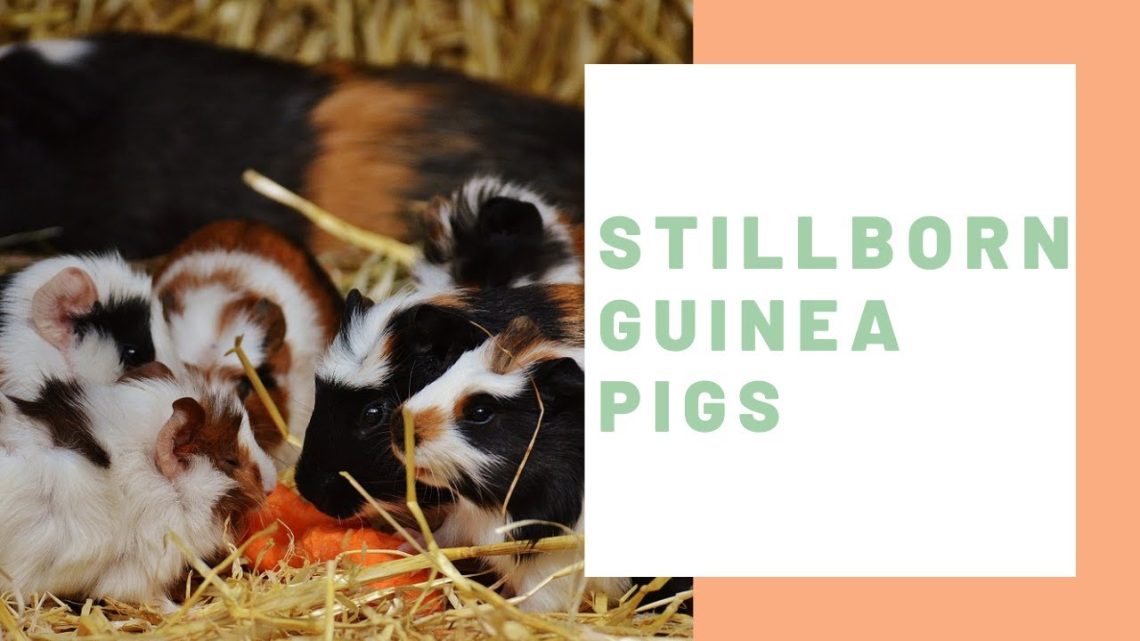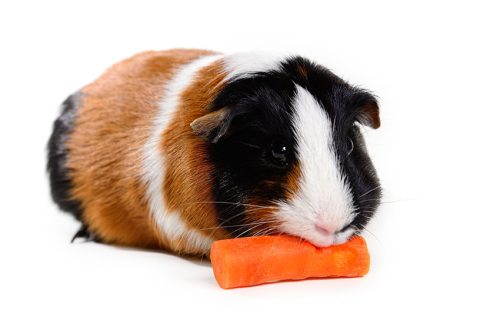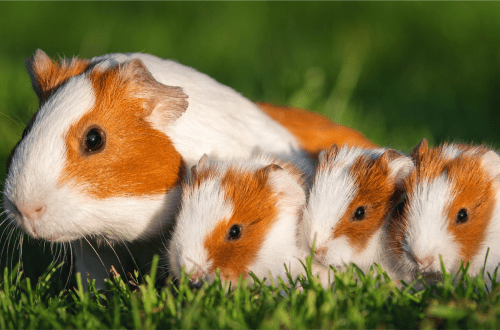
په ګیني سور کې لا هم زیږیدلي ماشومان
This situation can be encountered quite often. Sometimes a whole brood is born dead, despite the fact that the cubs are large and fully developed. Usually they are still in the fetal membranes, where they died due to suffocation, because the female was not able to properly release and lick them. This happens quite often with females who become mothers for the first time due to lack of experience, and usually there are no problems with the next offspring.
If, nevertheless, the problem occurs again, such a female should not be used for breeding, since the lack of maternal instinct can be inherited by cubs that manage to survive. The death of pups can be prevented if the owner of the mumps closely observes the birth process. In this case, if the female does not break the fetal membranes of newborns, you can always help her, thus minimizing the problem itself (see the article “Complications after childbirth”)
A litter born too early is most often either already dead or will die shortly after birth because the lungs of the young are not yet fully developed. These piglets are very small, they have white claws and a very short and thin coat (if any).
When two females are kept together, the birth of one gilt may trigger the birth of the other, as the second female will help the first to clean and lick the young. If at this time the second female’s due date has not yet come, she may give birth prematurely, and the cubs will not be able to survive. I have observed this phenomenon very often, and for this reason I stopped keeping two pregnant females together.
If a pregnant female has any disease, the cubs may die while still in the womb. For example, toxemia or Sellnick Mange are often the cause of such cases. If the female gives birth, she may survive, but most often she dies within two days.
Quite often you can find after birth that one or more cubs are dead. If the offspring are large, the young may be born at very short intervals. A female who has not given birth before may be so confused that she will not be able to lick one or more of the babies, as a result of which they will be found dead in an intact fetal membrane or dead from the cold if the mother fails to dry and take care of such a large number of babies.
In litters with five or more piglets, it is very common to find that one or two of them are dead. It is well known that babies are often stillborn after prolonged and complicated births. Very large babies may also be stillborn due to lack of oxygen during prolonged labor.
Despite the fact that almost all babies are born head first, some can come forward with the booty. During childbirth, this does not pose any problems, however, after childbirth, the female instinctively begins to gnaw through the membrane from the very end that comes out first, and the head will thus remain in the fetal membrane. If the baby is strong and healthy, he will start to move around the cage desperately and squeak, then the mother will soon notice her mistake, but the less viable piglets will most likely die. Again, such death can be avoided only if the owner is present at the birth and closely monitors the process.
As mentioned above, it is very difficult to prevent the birth of dead babies, unless the process is closely and constantly monitored. Everyone who breeds pigs will soon understand and accept the fact that a certain percentage of the young will be lost before or during birth. This percentage may vary among different breeds, and if records are kept, it can be calculated for each breed. In this case, it can be observed whether this coefficient increases for some reason, for example, due to infection with parasites (Selnick’s scabies) at an early stage. This disease is caused by the scabies mite Trixacarus caviae, which parasitizes the skin. Symptoms are severe itching, scratching of the skin, hair loss, as a result of severe itching, sores may appear. The pathogen is transmitted through direct contact of a sick animal with a healthy one, less often through care items. Ticks, multiplying, lay eggs that are resistant to environmental factors, and they serve as a factor in the spread of infection. Living mites outside the host do not live long. The mites themselves are very small and only visible under a microscope. For treatment, conventional acaricidal agents are used, for example, ivermectin (very carefully).
Maternal qualities of females were also mentioned. It is very characteristic that although some gilts never give birth to stillborn babies, others have them in every litter. For example, in Denmark, some breeds of Satin pigs (Satin) are distinguished by very poor mother pigs.
Maternal qualities are certainly hereditary, so the use of good mothers for breeding should be emphasized to avoid the problem of stillborn cubs.
The overall good health of the herd is another key to success, as only females in good condition, not overweight, can produce offspring without any problems or complications. A high quality diet is a must, and to succeed in breeding gilts, a diet rich in vitamin C is required.
The last thing I would like to mention is that, in my opinion, during childbirth, the female should be kept alone. Of course, it all depends on the particular breed, since there can be significant differences in the characters of the animals, but my pigs feel comfortable and relaxed when they are alone during the birth. On the contrary, a female who gives birth in the company is very often confused, especially if the companion is a male, who can begin his courtship directly at the time of birth. The result is a higher percentage of stillborn babies due to the fact that the mother does not release them from the fetal membrane. I’m sure there will be people who disagree with me on this issue. I would be very grateful for feedback on whether it is worth keeping the female during childbirth alone or in the company.
Reader reaction to an article about stillborn babies.
I am grateful to Jane Kinsley and Mrs. C. R. Holmes for their responses. Both argue in favor of keeping the females separate from the rest of the herd.
Jane Kinsley writes: “I completely agree with you on the point that two females who are about to become mothers should not be kept together. I only did this once, and I lost both broods. Now I keep the females in a special cage “for women in labor” with a separating net between them – this way they feel some kind of company, but they cannot interfere or somehow harm each other.
څومره عالي نظر!
Jane continues: “When it comes to keeping males with females, the situation varies. Some of my males are absolutely clueless in the matter of raising young and rush around the cage, representing a walking nuisance ”(Unfortunately, many “male” people behave in the same way). “I plant these shortly before giving birth. I have a couple of males who, on the contrary, serve as a standard of paternity, so I just watch what happens at the other end of the cage, and then I allow the cubs to cuddle up to them. Well, at least you tried. Whether a male is a good father can be determined by trial and error (just like with humans, right).
At the end of the letter, Jane Kinsley talks about a very special male named Gip (Gip – the word “pig” (pig, piglet), written backwards), he is the most caring father of all and never tries to mate with a female until she will not stop nursing her young (in fact, this is just an exceptional male, as he could be if he were a man).
Mrs. CR Holmes is a bit puzzled about keeping the pigs apart, as they can forget each other and start fighting and fighting when they are put back together. To be honest, I have not come across this, because I always tried to develop good social behavior in pigs, i.e. teach them to live with each other, regardless of age. Or perhaps Jane Kinsley’s grid partitioning could prevent such incidents?
© Mette Lybek Ruelokke
The original article is located at http://www.oginet.com/Cavies/cvstillb.htm.
© د الینا لیوبیمتسیوا لخوا ژباړه
This situation can be encountered quite often. Sometimes a whole brood is born dead, despite the fact that the cubs are large and fully developed. Usually they are still in the fetal membranes, where they died due to suffocation, because the female was not able to properly release and lick them. This happens quite often with females who become mothers for the first time due to lack of experience, and usually there are no problems with the next offspring.
If, nevertheless, the problem occurs again, such a female should not be used for breeding, since the lack of maternal instinct can be inherited by cubs that manage to survive. The death of pups can be prevented if the owner of the mumps closely observes the birth process. In this case, if the female does not break the fetal membranes of newborns, you can always help her, thus minimizing the problem itself (see the article “Complications after childbirth”)
A litter born too early is most often either already dead or will die shortly after birth because the lungs of the young are not yet fully developed. These piglets are very small, they have white claws and a very short and thin coat (if any).
When two females are kept together, the birth of one gilt may trigger the birth of the other, as the second female will help the first to clean and lick the young. If at this time the second female’s due date has not yet come, she may give birth prematurely, and the cubs will not be able to survive. I have observed this phenomenon very often, and for this reason I stopped keeping two pregnant females together.
If a pregnant female has any disease, the cubs may die while still in the womb. For example, toxemia or Sellnick Mange are often the cause of such cases. If the female gives birth, she may survive, but most often she dies within two days.
Quite often you can find after birth that one or more cubs are dead. If the offspring are large, the young may be born at very short intervals. A female who has not given birth before may be so confused that she will not be able to lick one or more of the babies, as a result of which they will be found dead in an intact fetal membrane or dead from the cold if the mother fails to dry and take care of such a large number of babies.
In litters with five or more piglets, it is very common to find that one or two of them are dead. It is well known that babies are often stillborn after prolonged and complicated births. Very large babies may also be stillborn due to lack of oxygen during prolonged labor.
Despite the fact that almost all babies are born head first, some can come forward with the booty. During childbirth, this does not pose any problems, however, after childbirth, the female instinctively begins to gnaw through the membrane from the very end that comes out first, and the head will thus remain in the fetal membrane. If the baby is strong and healthy, he will start to move around the cage desperately and squeak, then the mother will soon notice her mistake, but the less viable piglets will most likely die. Again, such death can be avoided only if the owner is present at the birth and closely monitors the process.
As mentioned above, it is very difficult to prevent the birth of dead babies, unless the process is closely and constantly monitored. Everyone who breeds pigs will soon understand and accept the fact that a certain percentage of the young will be lost before or during birth. This percentage may vary among different breeds, and if records are kept, it can be calculated for each breed. In this case, it can be observed whether this coefficient increases for some reason, for example, due to infection with parasites (Selnick’s scabies) at an early stage. This disease is caused by the scabies mite Trixacarus caviae, which parasitizes the skin. Symptoms are severe itching, scratching of the skin, hair loss, as a result of severe itching, sores may appear. The pathogen is transmitted through direct contact of a sick animal with a healthy one, less often through care items. Ticks, multiplying, lay eggs that are resistant to environmental factors, and they serve as a factor in the spread of infection. Living mites outside the host do not live long. The mites themselves are very small and only visible under a microscope. For treatment, conventional acaricidal agents are used, for example, ivermectin (very carefully).
Maternal qualities of females were also mentioned. It is very characteristic that although some gilts never give birth to stillborn babies, others have them in every litter. For example, in Denmark, some breeds of Satin pigs (Satin) are distinguished by very poor mother pigs.
Maternal qualities are certainly hereditary, so the use of good mothers for breeding should be emphasized to avoid the problem of stillborn cubs.
The overall good health of the herd is another key to success, as only females in good condition, not overweight, can produce offspring without any problems or complications. A high quality diet is a must, and to succeed in breeding gilts, a diet rich in vitamin C is required.
The last thing I would like to mention is that, in my opinion, during childbirth, the female should be kept alone. Of course, it all depends on the particular breed, since there can be significant differences in the characters of the animals, but my pigs feel comfortable and relaxed when they are alone during the birth. On the contrary, a female who gives birth in the company is very often confused, especially if the companion is a male, who can begin his courtship directly at the time of birth. The result is a higher percentage of stillborn babies due to the fact that the mother does not release them from the fetal membrane. I’m sure there will be people who disagree with me on this issue. I would be very grateful for feedback on whether it is worth keeping the female during childbirth alone or in the company.
Reader reaction to an article about stillborn babies.
I am grateful to Jane Kinsley and Mrs. C. R. Holmes for their responses. Both argue in favor of keeping the females separate from the rest of the herd.
Jane Kinsley writes: “I completely agree with you on the point that two females who are about to become mothers should not be kept together. I only did this once, and I lost both broods. Now I keep the females in a special cage “for women in labor” with a separating net between them – this way they feel some kind of company, but they cannot interfere or somehow harm each other.
څومره عالي نظر!
Jane continues: “When it comes to keeping males with females, the situation varies. Some of my males are absolutely clueless in the matter of raising young and rush around the cage, representing a walking nuisance ”(Unfortunately, many “male” people behave in the same way). “I plant these shortly before giving birth. I have a couple of males who, on the contrary, serve as a standard of paternity, so I just watch what happens at the other end of the cage, and then I allow the cubs to cuddle up to them. Well, at least you tried. Whether a male is a good father can be determined by trial and error (just like with humans, right).
At the end of the letter, Jane Kinsley talks about a very special male named Gip (Gip – the word “pig” (pig, piglet), written backwards), he is the most caring father of all and never tries to mate with a female until she will not stop nursing her young (in fact, this is just an exceptional male, as he could be if he were a man).
Mrs. CR Holmes is a bit puzzled about keeping the pigs apart, as they can forget each other and start fighting and fighting when they are put back together. To be honest, I have not come across this, because I always tried to develop good social behavior in pigs, i.e. teach them to live with each other, regardless of age. Or perhaps Jane Kinsley’s grid partitioning could prevent such incidents?
© Mette Lybek Ruelokke
The original article is located at http://www.oginet.com/Cavies/cvstillb.htm.
© د الینا لیوبیمتسیوا لخوا ژباړه





